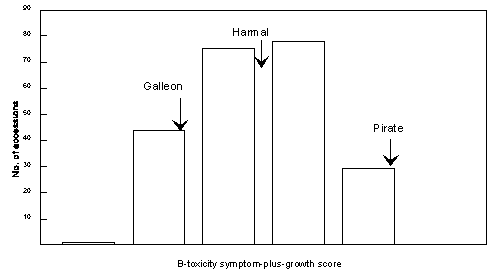
(1) Iraqi accessions
Previous screening of 50 Iraqi barley accessions at the seedling stage showed that one-fifth of the accessions were tolerant to boron (B) toxicity, and there were no very sensitive accessions. To confirm their tolerance, 15 accessions with lower B-toxicity symptom scores than Galleon, the moderately tolerant barley check, and low shoot B concentrations were grown in pots up to maturity in a plastic house. There were two treatments: control (0.5 ppm hot water extractable B) and +B (50 mg B mixed per kilogram of soil, giving a hot water extract of 26 ppm B).
The performance of the most B-toxicity tolerant accessions is presented in Table 1. All the lines in the table had lower B-toxicity symptom scores and shoot B concentrations than Galleon at the tillering stage. Moreover, unlike Galleon, they showed an increase in grain yield under the +B treatment, which might be due to their higher B requirement. The best accession had a 27 % yield increase. Results of the study confirmed the expectation that good sources of tolerance to B toxicity can be found in Iraqi landraces.
(2) Afghanistan accessions
This evaluation of 227 Afghanistan barley accessions was prompted by the identification of very tolerant durum wheat accessions from Afghanistan. Screening was conducted in a plastic house in big trays containing soil mixed evenly with boric acid at the rate of 50 mg B/kg soil. Hill plots of 5 seeds from each entry were sown, and there were two replicates. Foliar B-toxicity symptom and seedling growth scores were taken 4 weeks after sowing.
Figure 1 shows the distribution of the B-toxicity symptom-plus-growth score for the 227 accessions. Fifty-nine accessions (26.0%) had better score than Galleon. The most tolerant accessions were ICB 104046, 104047, 104169, 104057, 109017, and 121968. Besides, none of the accessions had a poorer score than the very sensitive check, Pirate. This finding on Afghanistan barley agreed with that in durum and bread wheat, and indicated that many soils in Afghanistan have high levels of B.
Table 1. Performance of the most B-toxicity tolerant Iraqi accessions.
| B-toxicity | Shoot B | |||
| symptom | conc. | Grain yield (g/pot) | ||
| Accession | score ?,? | (ppm) | Control | at + B |
| ICB 109419 | 2.75 | 319 | 8.1 | 10.3 (127)¶ |
| ICB 108477 | 0.75 | 103 | 7.7 | 8.9 (115) |
| ICB 109415 | 1.25 | 132 | 10.1 | 11.5 (115) |
| ICB 121426 | 1.75 | 225 | 8.1 | 9.0 (113) |
| ICB 109420 | 1.75 | 306 | 9.8 | 11.0 (111) |
| Galleon | 4.50 | 468 | 11.7 | 7.3 (65) |
| Mean (n=28) | 2.00 | 239 | 9.9 | 9.3 (95) |
?0-9 scale; 0 = no symptom, 9 = symptoms cover the first three leaves.
¶Yield of +B as a percent of control.
Figure 1. Distribution of B-toxicity symptom-plus-growth score for the
227 Afghanistan
barley accessions.

Return to the Table of Contents